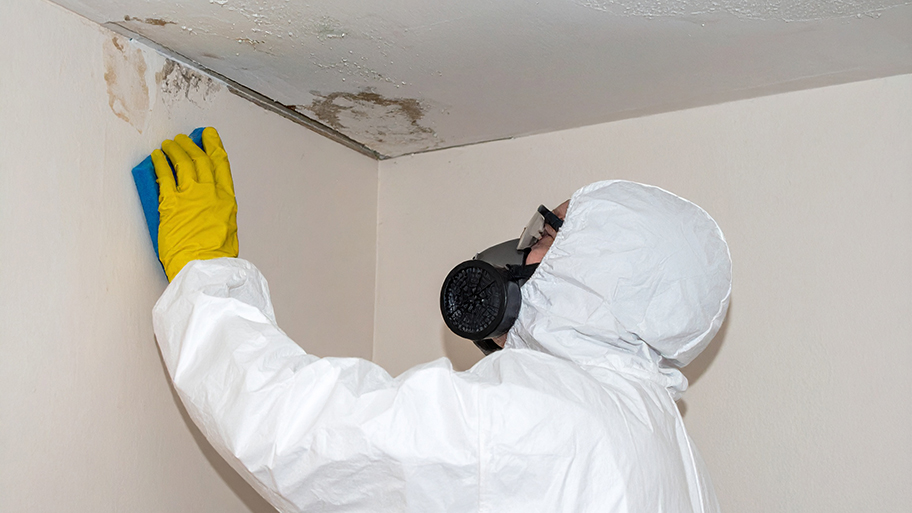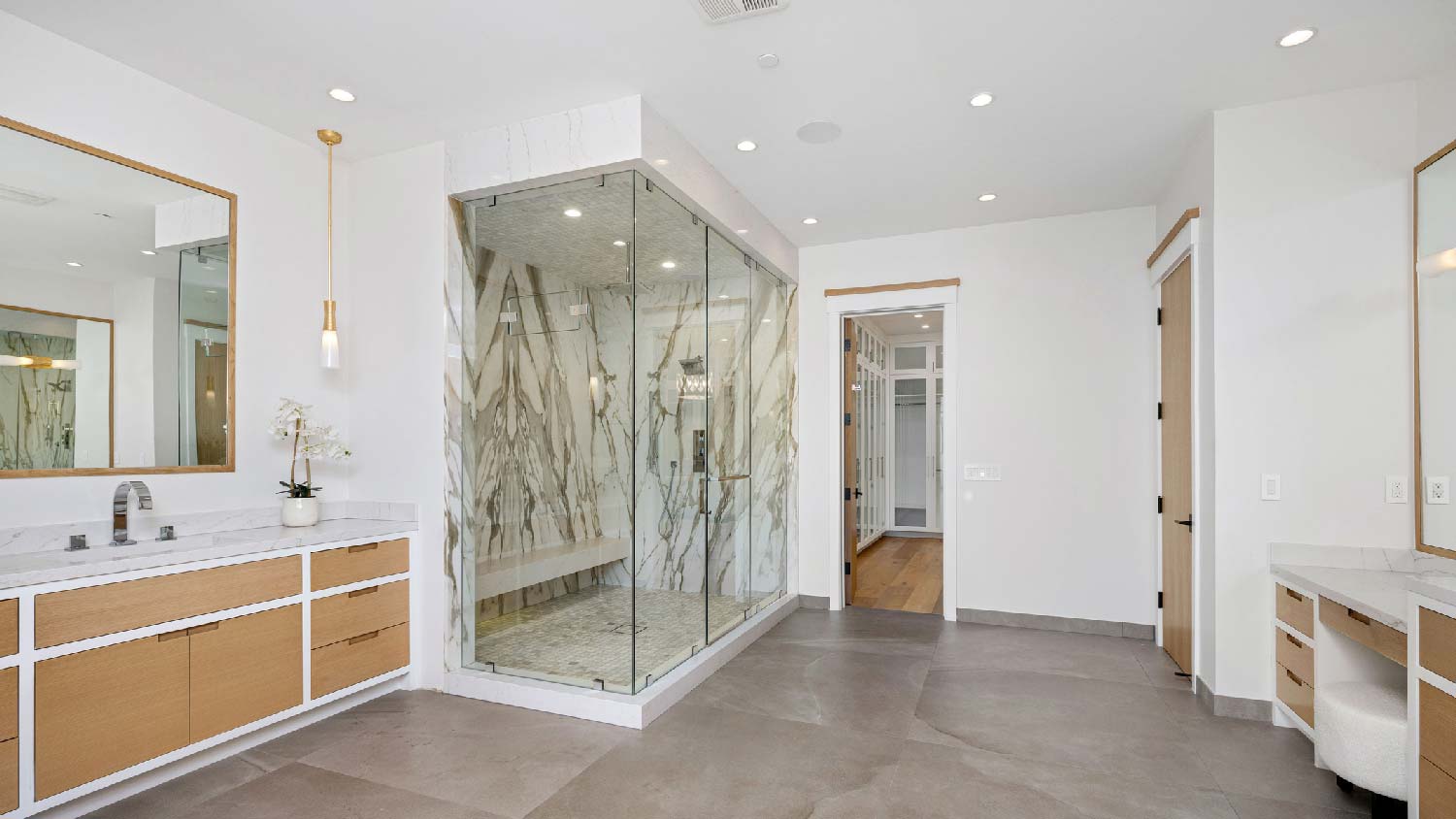
Mold remediation cost can quickly escalate. But if you have mold in your home, the cost for mold remediation is worth it.
Seeing black mold doesn’t have to mean dark times are ahead


Black mold can be black, dark green, or dark brown.
It looks like a black stain on a wall or another surface.
Up close, black mold has multiple circular patterns.
Some types of black mold can make you very sick.
You should hire a pro to clean black mold.
No one wants to see mold in a home. Not only does it indicate an unwanted source of excess moisture or leaking, but an exposure to mold can make you sick. If the mold is dark in color, you may have black mold. What does black mold look like? It’s often black with a round shape, but not always. Learning how to eliminate black mold in your home requires many of the same steps as removing any type of mold, including taking precautions to keep yourself safe.

Black mold looks like a dark-colored stain in an area where moisture appears. You may find it on walls, ceilings, bathtubs, showers, and around windows. If you have a damp basement or crawl space where you store boxes, black mold could appear on the cardboard or on paper in the area. It may show up on support posts and joists, too.
To be certain about what you are seeing, you may want to inspect it closer. Before doing so, put on a breathing mask, gloves, and goggles to avoid an unwanted exposure. What does black mold look like up close? Its color can be black, dark green, or dark brown. You may even see small patches or flecks of orange or white colors.
The stain usually consists of a series of circular patterns of varying sizes. It may have a fuzzy texture when viewed up close.

Often, you’ll hear that black mold is extremely dangerous to your health. But is black mold toxic?
Even though it is scary to see a patch of black mold on your wall, it may not make you extremely sick or kill you, according to the Cleveland Clinic. Black mold sometimes creates toxins you don’t want to inhale, but not always. The best advice is to always wear protective clothing and a breathing mask around black mold. Avoid exposing yourself to it if at all possible. Let the pros handle it for you.
Some of the health concerns associated with a black mold exposure include:
Issues with breathing, including coughing, wheezing, and sneezing
Allergic-like reactions, including itching, skin rash, eye irritation, and congestion
Infections in the lungs from regularly inhaling the spores
Neurological symptoms from regular exposure, including headaches, memory problems, and dizziness
Toxicity that requires medical care when inhaling toxins that the black mold releases
Although toxicity is not always present with black mold, it can happen in some circumstances.
The terms “mold,” and “black mold" are commonly used interchangeably, but there is a difference. Black mold is a specific type of mold. It’s typically black in color, but it can be green. And, unlike some types of mold, black mold is toxic.
Ultimately, you shouldn’t expose yourself to black mold if at all possible. For example, if you have allergies to black mold, you could end up becoming extremely sick. However, you may not realize you are allergic to black mold until you suffer an exposure and a severe illness.
Additionally, unless you are a mold inspection expert, you probably cannot know ahead of time if the black mold you are seeing has created toxins.
It’s best to take safety precautions around black mold every time you see it, including:
Wearing a breathing mask or a respirator
Wearing disposable gloves
Wearing goggles
Wearing clothing that you will wash immediately or discard
If you are wondering how to get rid of black mold, the answer is to rely on a professional. Call a local black mold inspection expert to confirm its presence. If black mold is found, hire a mold removal specialist near you to safely remove it.
You should never attempt to remove black mold on your own. By disturbing the patch of mold, you could release spores into the air that could enter your HVAC system and spread throughout the house. Wearing protective gear can’t prevent this possibility.
It simply isn’t worth the risk to try to do it yourself. Regardless of the size of the patch of mold infestation, it’s best to call in the pros. That’s why mold remediation experts are ready to help.
The mold remediation cost from a pro averages about $2,200, but your cost depends on the size of the infestation. A small job could cost quite a bit less. Ask the pro to give you a cost estimate, so you can properly budget for the work.
Allowing a pro to do the work typically comes with a guarantee of removing all of the black mold. The pro will do the work safely, giving you some peace of mind.
Cleaning the black mold may not be enough. You may need to discard items that have a black mold exposure. You also may need to cut out drywall with black mold and replace it with a patch.
Should you have a black mold issue inside the drywall, which can happen with leaking pipes or a leaking roof, replacement is the best option. A large space with black mold also may need repair instead of cleaning.
Contact a local mold removal expert for advice about what to do and to get a cost estimate.
Not all types of mold are black mold. The differences in black mold versus regular mold include the potential colors. Regular mold can be almost any dark or light color, including red, pink, orange, or gray, while black mold is always dark in color.
Often, black mold will have a slimier appearance than other types of mold. Additionally, it grows on porous surfaces, including drywall paper coverings, insulation, and wood. Other types of mold may grow on spoiled food, bread, and wood, among other places.
Even though black mold can appear on wood, it doesn’t necessarily mean the wood is unsalvageable. When considering black mold versus wood rot, if you notice discoloration on the wood, it could be black mold or regular mold that you can hire a pro to clean for you. Mold may appear on wood in a basement or crawl space.
However, if you are seeing wood rot, this indicates a problem that could weaken the wood, necessitating replacement or repair. Wood rot will appear as decay in the wood that appears to be eating away at it, causing visible damage, rather than just surface discoloration.
Both black mold and wood rot occur because of a problem with excess moisture in the area. Don’t just ignore mold forming on wood in a basement. The appearance of mold here indicates that enough moisture is present that wood rot could form eventually. Clean up any mold and look for the sources of moisture that you can fix.
You may need to reach out to a local general contractor for help with alleviating the issues with moisture in the area. The contractor can also help with making repairs in areas of wood rot.
According to data from Angi customers, 47.5% of homeowners request immediate assistance with mold removal, and 24.4% indicate the timing is flexible. Mold removal isn’t an emergency if it’s in a small area and no one in your home is experiencing any mold-related symptoms.
However, if the mold is widespread, someone in the home is experiencing severe allergy-type symptoms with no other explanation, or you have at-risk people in the house, you should request mold removal as soon as possible.
From average costs to expert advice, get all the answers you need to get your job done.

Mold remediation cost can quickly escalate. But if you have mold in your home, the cost for mold remediation is worth it.

The cost of a mold inspection might seem high, but it’s one of the best investments you can make for your health and home. Read on to learn cost-saving tips.

If you have mold, the odds are you also have mold mites. Here's what you need to know about getting rid of and preventing these diminutive pests.

Moisture, poor ventilation, and soap scum can all lead to pink mold in your bathroom. Here’s how to clean bathroom mold and prevent it from returning.

Mold is a common concern for many homeowners, especially black mold. Is black mold toxic? Yes, and that's why you need to know how to identify it.

Mold can enter your air ducts and lead to poor indoor air quality. Use this guide to learn how to get rid of mold in air ducts for healthier air.